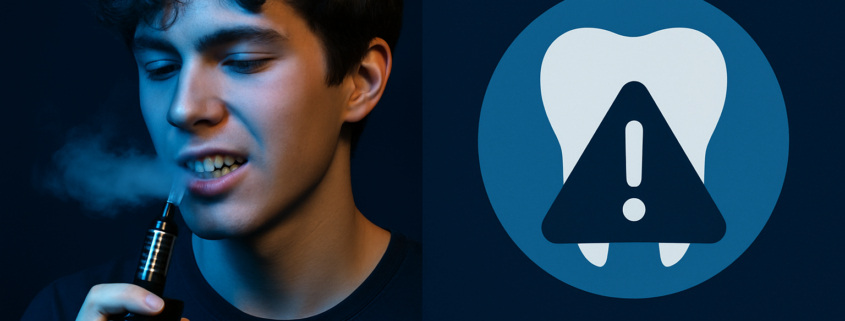How Smoking and Vaping Impact Your Teeth and Gums
You already know smoking is bad for your lungs. But what about your smile? From stained teeth and bad breath to gum disease and oral cancer, the impact of smoking and vaping on your oral health is more than cosmetic—it’s dangerous.
Vapes might seem like the “healthier” alternative to cigarettes, but when it comes to your gums and teeth, both are bad news. Nicotine and other chemicals in tobacco and e-cigarettes wreak havoc on your mouth’s ecosystem, turning it into a breeding ground for disease.
If you’re lighting up—or puffing clouds—it’s time to understand exactly what’s happening inside your mouth.
TLDR – Quick Guide
- Smoking and Vaping: Both expose your mouth to harmful chemicals that damage teeth and gums.
- Major Risks: Staining, bad breath, gum disease, tooth loss, and oral cancer.
- Vaping Isn’t Safe: E-cigarettes still deliver nicotine and other irritants that harm your gums.
- Why It Gets Missed: Nicotine masks early signs of disease, leading to late diagnoses.
- The Fix: Quitting and seeing your dentist regularly are the best defenses.
Detailed Breakdown
How Smoking Damages Your Mouth
Tobacco products are packed with toxins that directly impact oral tissues. Cigarettes, cigars, and smokeless tobacco all contain:
- Nicotine: A vasoconstrictor that reduces blood flow to your gums.
- Tar and Resin: Which stain enamel and contribute to tartar buildup.
- Carbon Monoxide and Carcinogens: That increase the risk of oral cancers.
Here’s what long-term use can do to your smile:
- Tooth Discoloration: Yellow and brown stains that brushing can’t fix.
- Persistent Bad Breath: Caused by dry mouth and bacteria buildup.
- Gum Disease: Smokers are up to 6x more likely to develop periodontitis.
- Slow Healing: After surgeries or injuries due to poor blood circulation.
- Oral Cancer: Especially in the tongue, lips, and throat.
Vaping: Not the “Safe” Alternative
E-cigarettes often get a pass in the wellness world, but let’s be clear: vaping still harms your mouth.
The aerosol from vapes contains nicotine, propylene glycol, formaldehyde, and heavy metals—not exactly what your gums need. Even without combustion, these chemicals:
- Dry out the mouth: Which increases risk of cavities and gum irritation.
- Trigger inflammation: Leading to redness, swelling, and bleeding gums.
- Alter oral bacteria: Creating imbalances that increase the risk of tooth decay and gum disease.
- Mask symptoms: Just like traditional nicotine, vape users may not notice gum issues until they’re severe.
A 2020 study in Science Advances found that e-cigarette users had bacterial profiles similar to people with advanced periodontal disease, even if they’d never smoked.
Why Nicotine Is So Deceptive
Nicotine doesn’t just get you hooked—it hides the symptoms of oral disease. It restricts blood vessels in your gums, which:
- Reduces visible bleeding (a common early warning sign).
- Delays your immune system’s response.
- Makes infections harder to detect and treat.
This means many smokers and vapers don’t realize they have gum disease until it’s already advanced.
The Long-Term Consequences
Let’s not sugarcoat it. If you continue smoking or vaping, here’s what you’re signing up for:
- Increased Risk of Tooth Loss: Gum disease is the leading cause of adult tooth loss, and smoking accelerates it.
- Dental Implant Failure: Smokers have significantly higher implant rejection rates.
- Jawbone Loss: Advanced gum disease can deteriorate the bone that supports your teeth.
- Costly Treatments: More cleanings, surgeries, and cosmetic repairs down the road.
What Your Dentist Can Do
Dentists are often the first to spot signs of smoking-related oral issues. If you’re a smoker or vaper, let them know. They can:
- Perform Oral Cancer Screenings: Early detection is key.
- Provide Deep Cleanings and Monitoring: To manage gum health.
- Recommend Quitting Support: From nicotine patches to counseling referrals.
- Offer Cosmetic Repairs: Whitening, veneers, or bonding for aesthetic concerns.
- Track Changes Over Time: With regular exams and digital imaging.
Pro tip: quitting now can reverse some damage, especially in the early stages of gum disease.
Key Takeaways
- Smoking and vaping are both major threats to your oral health.
- They increase the risk of stained teeth, bad breath, gum disease, and oral cancer.
- Nicotine hides early symptoms, making diseases harder to detect.
- Vaping is not a safe alternative—it carries its own set of oral health risks.
- Regular dental visits and quitting tobacco are your best defense.
FAQs
Does vaping cause less staining than smoking?
Yes, but it still causes discoloration over time due to chemical exposure—just at a slower rate.
Can I reverse damage if I quit smoking or vaping?
Some effects, like gum inflammation, can improve. But advanced issues like bone loss or tooth decay require professional treatment.
Is nicotine-free vaping safer for my teeth?
Removing nicotine helps, but other chemicals in vape juice can still irritate tissues and harm enamel.
What’s the best oral hygiene routine for smokers or vapers?
Brush twice a day, floss daily, use a fluoride mouthwash, and see your dentist every 3-4 months.
Should I tell my dentist I vape even if I think it’s minor?
Absolutely. Being honest helps your dentist tailor care and catch early warning signs.




Leave a Reply
Want to join the discussion?Feel free to contribute!